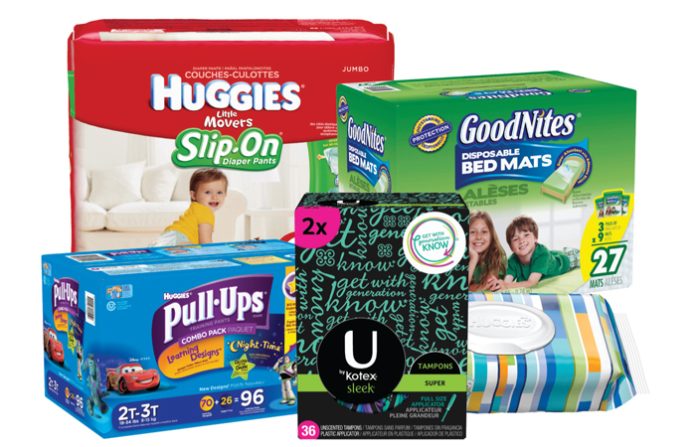Kimberly-Clark Corp., based in Irving, Texas, is one of the world’s foremost consumer personal products brands. Among the 141-year-old company’s best-known products are Kleenex facial tissues, Kotex feminine hygiene products, Cottonelle bath tissues and Huggies disposable diapers.
Kimberly-Clark’s major volume packaging includes cardboard cartons and cases, and plastic bags. Its Kleenex cartons are the largest in the carton category and its Huggies disposable diapers are among the largest volume in the printed bags category. Huggies and Pull-ups are the largest user of printed corrugated cases.
Kimberly-Clark also uses printed pressure-sensitive labels, in mold labels (IMLs), shrink wrap, shrink sleeves, header cards, u-boards, displays, shelf-talkers, coupons and other packaging and marketing materials.
Cartons are predominantly printed on web-fed offset presses,with sheetfed handling the rest. Bags are typically printed using flexography, with the occasional use of gravure presses, depending on where in the world the bags are printed. Corrugated cases are printed using either a flexo preprint liner or an offset printed litho laminated sheet. Volume is typically higher in the preprint liner.
Brand is of the utmost importance to Kimberly-Clark. Consumers often refer to facial tissues, feminine hygiene products and disposable diapers by their KC brand names: Kleenex, Kotex and Huggies. So having branded products look exactly the same on store shelves worldwide is essential. Allen Marquardt, product packaging manager at Kimberly-Clark (KC), is responsible for making sure that the printed packaging matches the original intent of the brand and is consistent around the world.
When the procurement department thinks a potential printer is a good fit for Kimberly-Clark, Marquardt does an ISO-style audit of the facility. “We’re assessing compliance: Are you doing what you say you do and are you doing the right things we’re looking for?” KimberlyClark scorecards its major suppliers on price, service, support and quality.
Marquardt said he often finds suppliers cutting corners rather than following their own internal processes to assure good print quality. “When done right, nearly all robust print processes assure predictable, consistent, repeatable and costeffective print results of a desirable nature. When corners are cut, suppliers often have to go back and do the job right, resulting in much greater costs to themselves than if they had insisted that their teams do it right the first time. I’m always pleased to encounter a supplier that truly embraces a LEAN thinking culture. They are nearly always the low-cost, high-quality supplier in their area of expertise.”
Best practices: running to the numbers
The main thing Marquardt is looking for is that the print supplier is running to the numbers. “RTN is a statement of support for the major industry best practices in print. In flexography, Marquardt tracks FIRST (flexographic image reproduction specifications and tolerances from the Flexographic Technical Association, or FTA). In offset, he tracks with G7, GRACoL or the publications of SNAP or SWOP. In gravure, it’s GST (gravure specifications and lerances). “Running to the numbers re-enforces that we’re looking for a robust best practice that a supplier is following to produce printed packaging for us,” he said.
The numbers refer to the key proper settings that each printer, prepress supplier and art agency has to use and follow to efficiently and effectively develop graphics for KC. “In flexography, when we say run to the numbers, that means that prepress has to characterize the printing press with the printer so that they have the right printing profile to use,” he said. “Then it’s imperative that the printer continues to use the same print settings they used to create the profile for all our production work. We don’t tell them what settings to use; they pick the settings that they feel are most beneficial to their operation. But we do insist they stick to them, hold to them and use them throughout the process so that we can develop predictable, consistent, repeatable and cost-effective graphics around that process.”
Predictable, consistent, repeatable and cost-effective
Predictability means that KC, the ad agency, prepress and the printer have analyzed the project before they even make files and plates so that they feel confident that the printing goals are achievable. Marquardt also wants to make sure that the colors are not so hard to build that the printer has difficulty holding consistency on press. Reliability implies that the first print looks the same as the middle and end of the run, without variation or variability. Repeatability means that the printer can get the job to run correctly on press even weeks later. “We want the process to be very robust so that it’s easy for them to repeat and run profitably and confidently. When you do all that,you find you drive cost out. The cost-effectiveness comes along with the predictable, consistent and repeatable process,” Marquardt said.
Allowing somebody to change targets on press introduces the subjectivity of the human eye, which will likely introduce variability on the store shelf…
It’s important that the prepress agencies know the printing press and the process that will be used to run the graphics and the final product on which it will be printed so that they can understand the color gamut of that particular press. As the artwork is being developed, a preproduction meeting is scheduled that includes the art agency, prepress, the printer, and sometimes Marquardt himself. “We’re all looking at the graphic, the PDF, and we’relooking out for difficult colors. We’re trying to see if we anticipate difficulties. If we do, we may run a trial or change the graphic to avoid difficult colors. We don’t want to put anything on the press that we aren’t confident that we can reproduce,” he said. “The goal is to set a target that is understood by us, as well as the printer, that everybody can hit and agree to, and let the process do its work.”
He added, “None of us in the graphic industry are doing anybody a service if we overpromise to our marketing teams or brand managers something that can’t be achieved on press. That will only lead to disappointment.”
Colors such as pastely greens or purples, or light tan colors like almonds are often difficult to build out of process on press. Oranges can also be difficult to build and screen. If they do all agree – with input from prepress and the printer – to use a ‘difficult’ color, they closely monitor how it comes out on the press.In those cases, Marquardt will work with the print supplier to get as close as they can and hold the target with a reasonable amount of effort. “I’ll either waive the current standard so they can operate out of the specification for that particular color or better yet, I’ll adjust the color target to the color they can actually hit and hold as long as it’s consistent with the rest of my product and branding around the world,î Marquardt said.
No press checks
Running to the numbers allows Marquardt to communicate color targets and color information all over the world to printers who can then accurately and effectively re-create them without anyone else being there. “As a rule, we don’t send people to do press run approvals. We insist that the printer match the proof and use the approved color targets,” Marquardt said.
Process development work has to be done well in advance of the work ever getting to the press. “We don’t want somebody standing at a multimillion dollar production press making color decisions that introduce errors into the process because they are using their eyes,” said Marquardt. “The human eye is very unpredictable and it can be tricked very easily.”
Instead of eyeballs, Marquardt insists that each of his printers uses a spectrodensitometer and color management software to accurately measure and control colors. Printers who work with KC know that Marquardt’s set limits are a delta error of two or less coming off the press with printed packaging. If the prints indeed come off the press with a delta error of two or less, the printer doesn’t have to call anyone to get an approval of whether the run can be sold.
“Nobody has to make a decision of whether it’s a go or no go,” Marquardt said. “Imagine somebody walking into a pressroom where the printer knows they are at their color targets and running very good and that person says, ‘You know, that red brand color doesn’t quite look right. Can you tweak it and make it more pink for me?”
“When the printer knows he’s in spec, he can say, ‘No. We’re in spec to the standards and targets, which is defended by KC and the graphics team. I need to stay here.” And the printer knows that KC will buy the print run.
Allowing somebody to change targets on press introduces the subjectivity of the human eye, which will likely introduce variability on the store shelf – something KC definitely does not want to happen. Any changes need to be made to the proof and color targets before going back to press. On the other hand, running to the numbers is a very stable, wellthought-out, measurable process that sets targets and limits that everyone involved – from art agency to prepress to the printer and KC – can agree to. And it delivers predictable, consistent, repeatable, cost-effective results for everybody.
“We at KC know it’s a standard that printers will meet and I’m confident that it’s going to deliver shelf equity around the world,” Marquardt said. “And the printer is confident that they’re not going to have a print run returned to them because somebody thinks that it’s out of spec. If you use your eyeball to judge it, you’re bringing in variability and increasing inefficiencies. Spectrophotometry and running to the numbers eliminates those issues when it’s used by all parties involved.”

















